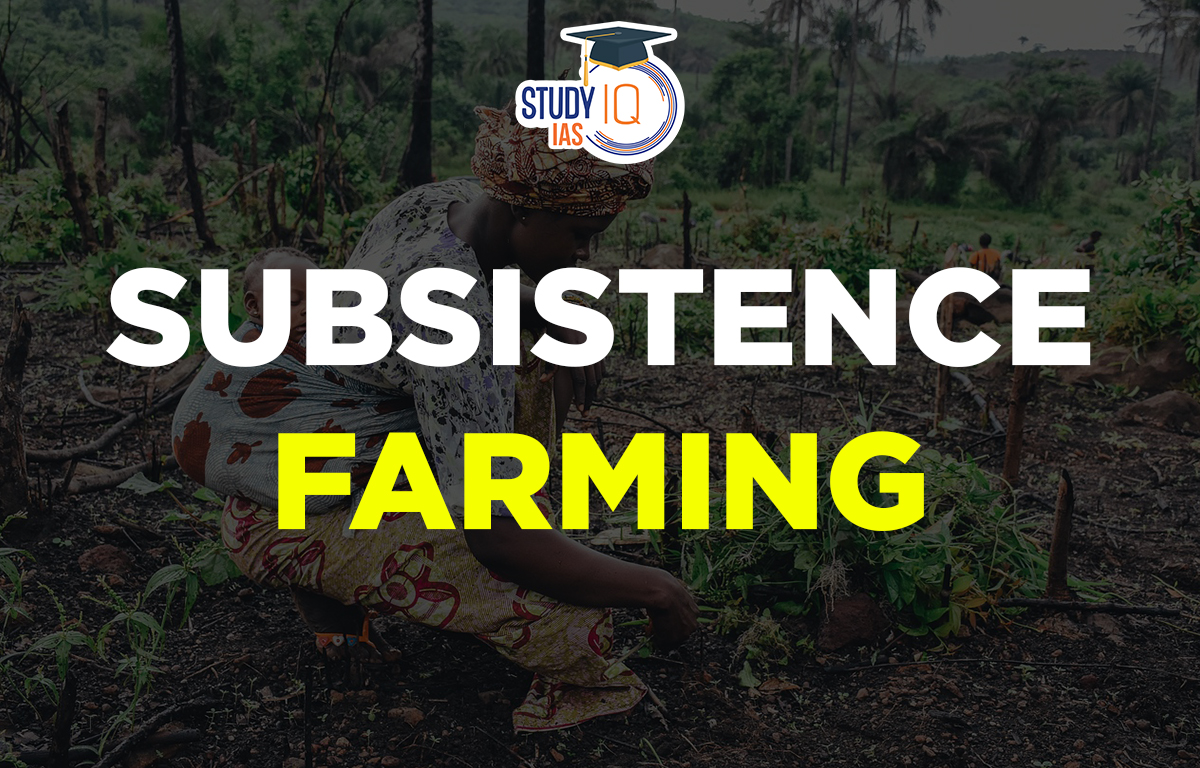Table of Contents
Subsistence Farming
Subsistence Farming is a form of agriculture where almost all the produce goes to feed and support the household. It is a type of agriculture in which a farmer produces crops and rears animals to fulfil the needs or requirements of his family and not for the market. This farming is found in less developed and developing countries, mainly in tropical regions. A striking feature of farming is its scattered distribution; small patches of tilled land are surrounded and separated by broad stretches of forest.
A classic example is Nagaland in the northeast hilly region of India. In the hill tracts and valleys, Naga people follow this type of farming. Considering the region’s natural environment, the Naga people cultivate paddy and produce rice.
Read More: Energy Resources
Subsistence Farming Nature and Method of Cultivation
Under Subsistence farming, farmers with their traditional tools and agricultural implements till the land and harvest the crops. They produce what they need. To fulfil their own requirement they grow a variety of crops. All the family members involve themselves in farming. Hence, it acts as family farming.
Subsistence farmers mostly rely on rainfall to grow their crops. Sometimes, they use water from local ponds or reservoirs to irrigate their land. They take care of all their farming needs themselves, and the crops they grow are mainly for their own consumption, not for selling in the market.
Read More: Natural Gas
Subsistence Farming Examples
Subsistence farmers produce a variety of crops according to the agricultural environment of the region. In tropical and sub-tropical countries, they grow tropical and subtropical crops like manioc, yams, millets, rice, vegetables, sweet potatoes, cassava, peas, groundnuts, and cotton based on the needs of their families. They grow barley, corn, wheat, sugar beet, potatoes, and vegetables in temperate regions.
Read More: Coastal Landforms
Subsistence Farming in India
In India, subsistence farmers who grow millets are receiving help from larger companies and organizations. For example, the Indian Council of Agricultural Research (ICAR) and the Indian Institute of Millets Research (IIMR) are providing support and resources to these small farmers.
These farmers also play an important role in preserving many traditions. So, for a subsistence farmer, agriculture is not just a job it is a way of life. Subsistence farming is done mainly for survival, not to make money. Even with hard work, it often doesn’t provide enough for the farmers’ needs. This type of farming is common in remote areas where it is hard to reach, like rugged mountains and difficult valleys, far from cities and modern life. You can find subsistence farming in small patches in underdeveloped mountainous regions or remote valleys in Asia and Africa. In India, it is mostly practiced in the hilly northeastern areas. It is also seen in places like Nepal, Bhutan, Myanmar, Ethiopia, Sudan, Uganda, Kenya, and Sri Lanka.
Read More: Types of Soil in India
Subsistence Farming Characteristics
Subsistence agriculture is characterized by the following features:
- Subsistence farming is done on small plots of land without heavy machinery.
- Most work is done by hand using traditional tools.
- The crop yield is low, often not enough for the farmers’ families.
- There is usually no extra produce to sell at the market.
- It relies maximum on manual labour and sometimes uses animals for help.
- Farmers depend on nature for rainfall and face pressure from a growing population.
Read More: Monsoon in India
Subsistence Farming Demerits
Subsistence farming has several demerits or disadvantages, some of which include:
- Low productivity
- Limited access to inputs and markets
- Vulnerability to climate and environmental shocks
- Low income
- Limited opportunities for diversification
- Land degradation and deforestation
Read More: soils
Subsistence Farming Merits
Despite the challenges and disadvantages, subsistence farming has some merits or advantages, including:
- The influence of market forces on the crop production pattern is insignificant.
- Food security because farmers produce crops for their requirements only.
- Farmers try to maintain the fertility of the soil.
- Preservation of traditional knowledge
- Environmental sustainability
- Low financial risk
- Contribution to local economies
- Resilience
Read More: Natural Vegetation of India
Subsistence Farming UPSC
In India, the majority of farmers engage in subsistence agriculture or cultivating for their own consumption. The farmers and their families consume the majority of the crop, so there is none left over to be sold on the market. Small and dispersed landholdings and rudimentary, archaic cultivation methods are used in this style of farming. Modern machineries like tractors and agricultural inputs like chemical fertilisers, insecticides, and herbicides are completely absent. In this type of farming, grains are mostly grown along with sugarcane, oilseeds, legumes, and vegetables.
Read More: Rainfall


 Story of Meera Bai and Her Devotion For ...
Story of Meera Bai and Her Devotion For ...
 Desert Climate, Distribution, Climatic C...
Desert Climate, Distribution, Climatic C...
 Deserts of India Map, Features of Thar D...
Deserts of India Map, Features of Thar D...





















